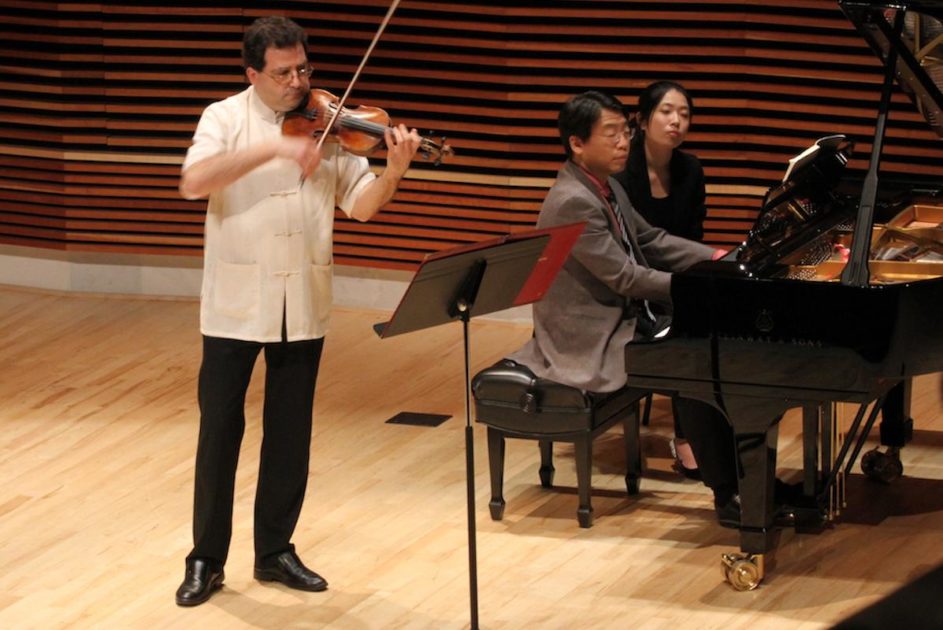Listening to violinist Miroslav Hristov and pianist Chih-Long Hu play Ludwig van Beethoven’s 1797-98 “Violin Sonata No. 1 in D Major,” Op. 12, No. 1, one might think this music is a piano sonata with violin accompaniment.
Indeed, many of the sonatas written for the two instruments in the late 18th century were identified exactly that way. The three-instrument combinations that include the piano are still identified as piano trios because the piano consistently has the heaviest workload.
The significance of Beethoven’s complete cycle of violin sonatas – which Hristov and Hu are undertaking on three successive Monday evenings that began this week at the University of Tennessee’s Sandra G. Powell Recital Hall at the Natalie Haslam Music Center – is how much Beethoven changed the relationship between the piano and violin in this chamber music form by developing the violin’s role. The difference was easily heard in the span of the three sonatas of opus 12 played Monday. It will be even more so as the trios progress through No. 10 in opus 96, written 15 years later.
It’s also interesting that the three sonatas on this program were dedicated to Beethoven’s teacher Antonio Salieri, a name seared in the memories of many classical-music audiences today as Mozart’s nemesis, largely because of the 1984 movie “Amadeus.”
The most interesting moments in the D Major sonata were the nervous quavers and sets of tumbling triplets, along with the energy produced by the fast rhythm in the “Rondo: Allegro,” third movement.
The Op. 12, No. 2 “A Major” sonata was a different matter. It had a sense of wit and switching of roles, with Hristov playing the part normally assigned to the piano and Hu playing what would normally be a violin melody.
The middle movement, marked “Andante, più tosto allegretto” (“steadily, but somewhat brisk”), was endearing and had a very appealing sense of comfort before the comic sense took off again at a “pleasingly fast” pace in the third movement.
In the third in the Opus 12 group, “Sonata No. 3 in E-Flat Major” presents the violin and piano in full-force competition for attention in the opening movement. But both Hristov’s playing and Hu’s were filled with poetry and beauty.
The fourth sonata on the program was “Sonata No. 4 in A Major,” jumping forward to Opus 23, written in 1801. The exchanges between the violin and the piano were often interesting. But there were also times when each didn’t seem to care what the other was doing.
The second concert in this series, at 8 p.m. Monday, Feb. 18, will be sonatas 5, 6 and 7. The “Sonata No. 5 in F Major,” Op. 24, widely known as the “Spring” sonata due to its sunny, cheerful disposition, is probably the best known of all of Beethoven’s violin sonatas because of the “Adagio molto espressivo,” second movement, being featured in the Broadway play “Fame.”
The third concert, at 8 p.m. Monday, Feb. 25, will complete the cycle with sonatas “No. 8 in G Major,” Op. 30, No. 3; “No. 9 in A Major,” Op. 47; and “No. 10 in G Major,” Op. 96. Classical-music fans and literature aficionados will be most familiar with “Sonata No. 9 in A Major,” Op. 47, known as the “Kreutzer Sonata.” The music was the inspiration for Leo Tolstoy’s novel “The Kreutzer Sonata,” as well as the Janáček/Coxe-reconstructed piano trio “The Kreutzer Sonata,” based on Tolstoy’s novel, arranged from Janáček’s “String Quartet No. 1.”
Like many of the concerts at UT, this series is free. Free parking is also available in the large parking lot behind the Haslam Music Center building.
More information about the many concerts presented at UT can be found here.

